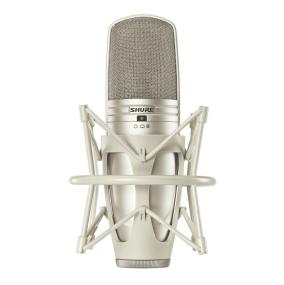Shure KSM44A Multi-Pattern Condenser Microphone - Large Diaphragm Side-Address Mic with Subsonic Filter, Prethos Advanced Preamplifier Technology and 3 Polar Patterns for Great Recording Flexibility


Premium microphone with three polar pattern options (cardioid, omnidirectional, bidirectional).
The Shure KSM44A is a premium, large-diaphragm, side-address condenser microphone with multiple polar pattern options (cardioid, omnidirectional, bidirectional). The refined and sophisticated design of the KSM44A features an externally biased, dual 1-inch diaphragms, extensive internal pop filtering and PrethosTM Advanced Preamplifier Technology for a ground-breaking threshold minimum of self-noise. The KSM44A is the premier choice for the highest level of professional studio and stage performance.
The KSM44A provides superior results in any application requiring a high quality microphone. Some typical applications are listed: Voice-solo, background, voice-over or broadcasting. Acoustic instruments such as piano, guitar, drums, percussion, strings. Wind instruments-brass and woodwind, Low-frequency instruments such as double bass, electric bass, kick drum, Overhead miking-drums or percussion, Ensembles-choral or orchestral, and Room ambience pick-up-guitar amplifier or drums. (Acoustic environments and microphone placements strongly affect the sound obtained from mik- ing a source, especially with a high-resolution microphone like the KSM44A. You may need to experiment with placement, room treatments and polar pattern to achieve the best overall sound for each application.)
The three position switch on the front of the microphone sets the polar response pattern. This changes the microphone’s sensitivity to sounds coming from different angles: Cardioid - Picks up sounds directly in front of the microphone and is least sensitive to those in back. This is most commonly used in studio recording and live-sound applications. Omnidirectional - Picks up sounds from all directions. Best for picking up room ambience and for miking several sources simultaneously, such as an ensemble or multiple singers. The om- nidirectional polar pattern exhibits no proximity effect. Bidirectional - Picks up equally from the front and back of the microphone while rejecting sounds from the sides. Often used for stereo recording (such as mid-side and Blumlein techniques).
A three-position switch on the back of the microphone lets you adjust the low-frequency response. Use the low-frequency filter to reduce wind noise, room noise, or proximity effect. Flat response - Provides the most natural sound in most applications. Low frequency cutoff - Provides an 18 dB-per-octave cutoff at 80 Hz. Helps eliminate floor rumble and low- frequency room noise from heating and air conditioning systems. This setting may also be used to compensate for proximity effect or to reduce low frequencies that make an instrument sound dull or muddy. Low frequency rolloff - Provides a 6 dB-per-octave rolloff filter at 115 Hz. Use this to compensate for proximity effect or to reduce low frequencies that could make an instrument sound dull or muddy.

This microphone requires phantom power and performs best with a 48 Vdc supply (IEC 61938). However, it will operate with slightly decreased headroom and sensitivity with supplies as low as 11 Vdc. Most modern mixers provide phantom power. You must use a balanced microphone cable: XLR-to- XLR or XLR-to-TRS.